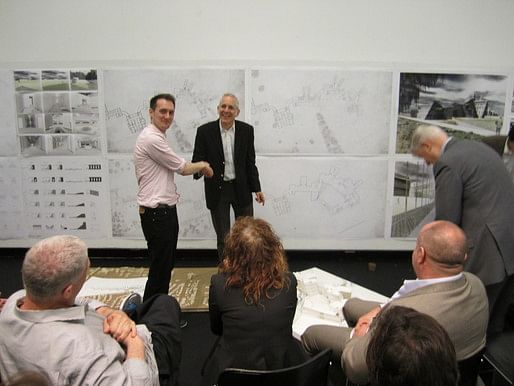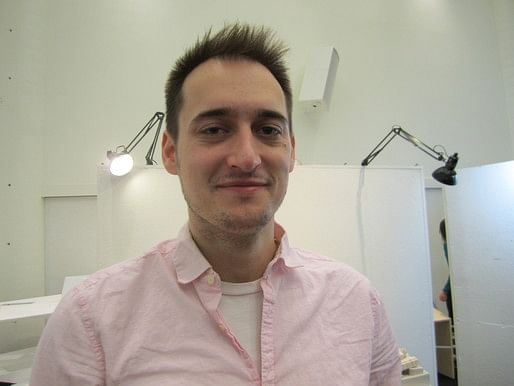
Hi Archinect,
10:44: Drew begins.
The focus here moves from the adaptation of self to the adjustment of nature...For centuries, architects have attempted to [cure] the self through what I'll term 'environmental modification.' In contrast there is biological modification, as in the film Equilibrium (2002), in which feelings are illegal and medicated against.
With modernity, we turned closer to biological modification over environmental modification.
...For all this difference [in contemporary buildings], it just looks different. It's difference for difference's sake. The premise of my thesis is to find architectural agency...through a return to history. Before media, drugs, wifi, and modernity. I stumbled across the notion of the total institution--Erving Goffman wrote about it--prisons, monasteries.
"Just a note--I'm going to say things that are obviously offensive today, but I'll be using the historic terminology..." Panoptic prisons, pavilion hospitals, Kirkbride Asylums... Kirkbride Asylums use the gaze as an instrumental tool.
How did architecture cure? I read this manual from the 1850s by Thomas Kirkbride; it laid out both architectural and medical practices. It laid out a strategy for curing, in four buildings. The first strategy is to separate buildings. Male and female on either side, and as you move out to farther buildings, that is where the more insane are held. A third strategy strategy: because the city was seen as the cause of madness, to an extent, nature was part of the cure, so the building sat in the landscape...with a pleasure ground. Collectivity was the fourth strategy.
Disclaimer: Asylums are no longer built today; people with mental illnesses are prescribed drugs and these buildings don't exist.
My idea was to erase the inconsequential, and to recreate a contemporary version of H. H. Richardson's asylum in Buffalo. [Manipulating these four conditions through scripts, retaining the gradient of least to most disruptive patients.]
The most disruptive are housed here, where corridor and bedroom are one.
JK: Let me try to restate your thesis. You argue that difference is an important goal in architecture, that it didn't seem to have any instrumentality. So you're looking for a test case where purpose-built thought...could be tested. So it's more about: can purpose-built thought produce a more effective architectural difference, rather than stylistic difference? So why stipulate the 1850s criteria? You've got to say something about whether this is a better example of architectural difference.
DC: I think it is if we existed in the 1850s.
DC: Progressively, you see...this 19th century T shape turn into a modernist box.
WJ: Some of the transformations are smooth and some are chopped incrementally, by storey...
DC: I think it's truer by stacking, rather than by smooth transitions. Each ward is individual.
CI: But are you just taking the standard categories from the less crazy to the more crazy? That's a formula for pushing the project. But then we're left with a plan; a planar project, which is interesting, but I'd say it's at odds with the drive of the project through the asylum.
IR: It's a question of how a typology is parametrized.
JK: It's highly rationalized. You should show us Herzog and de Meuron--arbitrary difference--and then show us your project in relation.
CI: I think it's a very interesting project and quite rigorous in its attention to something that unfolds over time. If the visuality becomes the dominant control--the monitoring of the patients, the view into the courtyard--that restricts the possibilities of tapping differentiation. It's actually very limited in that sense, just about eye contact.
WJ: That's a good point. To be a truly effective difference--in the same way that it's generally understood now that ideas come into being through metaphor, through which ideas can be operationalized--in the way that we understand Shakespeare introduced so many ideas into English through his metaphors. You have a set of formal tools and can do this all day. But when it turns into a new diagram, that's the real difference. That's the key, not what it looks like.
Cameron Wu: But the serenity of the single-loaded corridor, when it finally is turned 180 degrees; that's frightening.
Harry Cobb: In the 19th century version, there's a series, but just a series--one after the other. This series closes on itself, to make a space. To me that's the difference. Why?
DC: They turn in on themselves so that the court flips sides from back to front; it creates a global circle. Almost like a global surveillance.
CI: ...Your proposal for differentiation has gotten chunky...Why doesn't it have skin differentiation?
DC: It does: Richardson is the brick. The first building has brick as well, but it becomes a brick screen, and then you get full glass.
CI: I just wonder if--
JK: W--
CI: I'm still talking, Jeff. Don't talk: listen.
I just wonder if there could be a relationship between the brick and glass that makes sense as a transformational development. Otherwise there's no content or significance to it.
JK: The two most scary buildings I've seen in my life are across the street--Harry Cobb--and I hope you take it as a compliment. Either is fine on its own but as two, they're like twins staring at each other across the street. It would be so wonderful to compare this to the Vitra stacked houses.
WJ: To me the game is the extent to which you are using the tools of automatic design, then intervening. The decision to rotate the levels as opposed to smoothly transitioning them. The question becomes the degree of trust--the degree to which you accept the results of the machine, and the degree to which you impose--and not in a pejorative way--preconceived intents.
PSC: The issue here isn't how we use computers.

CI: I think Scott's right. I never thought about it this way, as a kind of inevitable historical rotation [of this building type].
HC: The reason the project has grown on me is that, I've come to appreciate it as a speculation about what a way of working will produce.
JK: When you circumnavigate, do you find that disturbing? These are pitched roofs divided...
HC: I know; I'm no longer interpreting it [as a building]. It's a thesis--a set of ideas that you speculate about through making a work. It remains speculative, which is why I appreciate it, without becoming to definitive.
Rodolphe el-Khoury: ...If roof shears it becomes pure icon...
CI: One assumption that is made is that when you show a transformation in a building you're bringing with you where you came from. Maybe you're queuing, depending on, Richardson. You could probably have done a little more careful queuing, rather than splitting. And maybe the roof that Rodolphe was talking about, would queue so that everything is not just up for grabs.
...
Thanks for reading!
Lian


This blog was most active from 2009-2013. Writing about my experiences and life at Harvard GSD started out as a way for me to process my experiences as an M.Arch.I student, and evolved into a record of the intellectual and cultural life of the Cambridge architecture (and to a lesser extent, design/technology) community, through live-blogs. These days, I work as a data storyteller (and blogger at Littldata.com) in San Francisco, and still post here once in a while.



No Comments
Block this user
Are you sure you want to block this user and hide all related comments throughout the site?
Archinect
This is your first comment on Archinect. Your comment will be visible once approved.